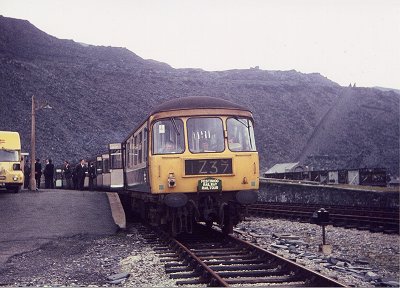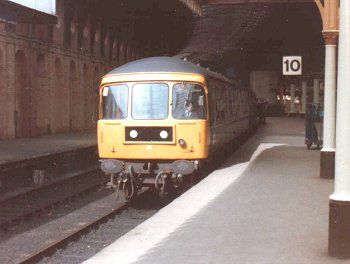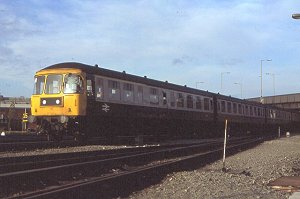Class 124 Swindon Trans-Pennine 6-car DMUs
Operations
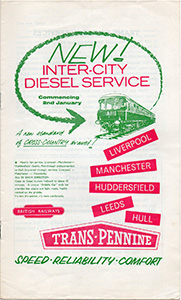
On January 2, 1961, British Railways, North Eastern Region, in conjunction with the London Midland Region, launched its inter-city diesel multiple-unit passenger service, now branded the "Trans-Pennine," between Hull and Liverpool. At the same time an improved passenger service was introduced between Newcastle and Liverpool operated by EE Type 4s (Class 40s). All services were greatly accelerated. Important parts of the Trans-Pennine route would have regular interval, half- hourly, or hourly fast trains. Connections were also greatly improved, and the LMR emphasis that there was greater comfort as well as speed and reliability.
Service Improvements
Hull - Liverpool
The former three steam services were scrapped, replaced by five through express diesel services in each direction every weekday. The new services reduced the 3 1/2 hour steam timings by an average of 45 min, with a corresponding speed-up at intermediate stages. The biggest acceleration, compared with steam timings was 67 min. Improved connections were provided at Leeds.
An example given of what the new service meant for a the Hull businessman was: he would be able to leave his office at about 9.00am, catch the 9.13am train, lunch with his associates in Manchester, attend a two hour meeting, return by the 4.40pm from Manchester, have tea on the train, and get back to Hull at 6.58pm in time for a normal evening meal at home.
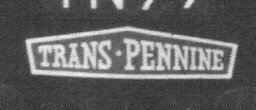
Initially the sets carried this orange headboard, and routeboards attached to the rooflines of intermediate vehicles.
Leeds - Manchester - Liverpool
The main impact of the new Trans- Pennine service was on the Leeds - Manchester - Liverpool route, where an hourly interval service was be provided. Express trains left Leeds for Liverpool at 45 min. past the hour from 07:45 until 19:45 (except at 09:45 which was to Manchester only). An additional train left Leeds at 10:18 for Liverpool, and there were also additional trains to Manchester at 08:00 and 09:15. In the reverse direction express trains left Liverpool for Leeds at 07:50, and hourly from 09:00 until 19:00.
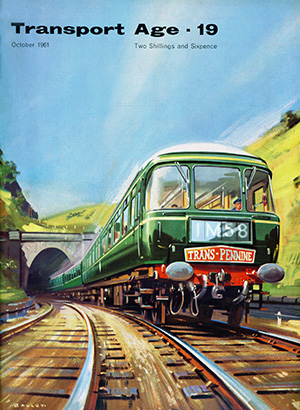
Local Services
There was an hourly diesel stopping service between Leeds and Huddersfield which, with the fast service, provided half-hourly services between these points throughout most of the day. Also a two- hourly stopping service operated between Huddersfield and Manchester, and an hourly diesel stopping service between Liverpool and Manchester via Tyldesley will gave improved connections with the new inter-city service.
In addition there were better connections from the North East to Stoke, Crewe, Birmingham, the West of England, and South Wales, via an improved diesel service between Stalybridge and Stockport.
Improved connecting services from York and other places not on the direct Trans-Pennine route were an integral part of the new service. For instance, from York the scheme included an additional train to Leeds leaving York at 09:25 connecting with the 10:18 Trans-Pennine train at Leeds, and arriving in Liverpool at 12:06.
About 15 min. was saved on the average journey time even between Leeds and Manchester, and about 12 min. between Huddersfield and Manchester. Between Leeds and Liverpool the average saving was 27 min.
Success
During the first week (January 2nd - 8th 1961) over 13,000 people used the new trains from Leeds, Hull and Huddersfield alone. The NER announced that from Hull and Huddersfield the number of passengers on the route had increased by 30% and from Leeds the number had increased by 45%.
Not all were happy with the changes to the timetables on the 2/1/61, particularly to the feeder services for the Trans-Pennines. Mr Charles Grey (MP for Durham) and Mr William Ainsley (MP for Durham NW) protested in the Commons about the alterations which they claimed greatly affected Durham. The Minister of Transport replied that the changes were justified and he did not intend to interfere with the BTC's statutory responsibility for running the country's trains.
In March 1961 passenger traffic on the Trans-Pennines had increased 100%.
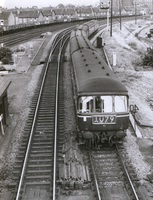
The house magazine of Leyland Motors, the Leyland Journal interviewed some passengers to find the reason for it's success. One regular passenger claimed the new sets had added a "new dimension" to rail travel. The griddle car was well praised, and a man said it was just not worth travelling by car. Along with services between Liverpool Lime Street and Manchester Exchange which had jumped by as much as 125%, the magazine concluded that the bus-type frequency was the biggest attraction.
The image shows a set about to cross the swing bridge at Selby in 1962. Huddersfield Examiner.
Timings
The new service appeared for the first time in the Summer 1961 timetable, where it was noted that it introduced several mile-a-minute runs to the NER. Two of the Trans-Pennines were booked to cover the 20.5 miles from Brough to Selby in 20mins start to stop, and there were two 31min bookings over the 31.0 miles from Hull to Selby. The non-stop timing of 57mins over the 51.7 miles from Leeds to Hull by the 13:51 was 14 mins faster than any previous schedule, even diesel. The quickest from Liverpool to Hull was the 12:00 from Lime Street which took just 2hrs 48mins for the 125 miles (an average of just under 45mph) with stops at Earlestown, Manchester Exchange, Stalybridge, Huddersfield, Leeds and Selby. In the reverse direction the fastest was the 09:13 and the 15:43 from Hull, each taking 2hr 54 min with six intermediate stops.
This video clip includes a set departing from Liverpool Lime Street, five vehicles are in green and the trailer second in blue/grey:
Buffets
One of the most popular features on the new service was the Griddle buffet. These were operated by a staff of two and could provide immediate service of hot or cold snacks at any time, either in the buffet or in the three adjacent compartments. A good variety of dishes included hot griddle-cooked Aberdeen-Angus beef in toasted bread roll with butter, (1961) price was 1s 9d, or with fried egg 3s.
Unfortunately the bogies fitted to the new units were of the same pattern to those fitted to the Swindon 79xxx / Class 126 'Inter-City' units which, sometimes, did not give a good ride on the many tight curves which are a feature of the Trans-Pennine route. Buffet car patrons were vociferous with their complaints and more than one customer had their coffee or beer tipped over them when the unit was cornering at speed!

The image shows buffet E59776 at Leeds in the early 1970s. Malcolm Clements.
The competition from the M62 and the falling standard of the sets saw patronage fall and the buffets were the first to go. In 1971 59774/5/80/1 were stored unserviceable, and five car sets began to appear regularly.
The summer 1973 timetable from the 1st May actually increased the buffet car diagrams. With a requirement of 5 cars (allowing for one under maintenance), 59775 was reinstated. At about this time the lighting in the remaining buffets were improved, and just before that, the original green curtains were replaced with the standard orange ones (as fitted to the other vehicles) The three stored cars were condemned on 6/8/72 and were scrapped at BSC, Rotherham.
The buffet revival reintroduced the Griddle service which had been discontinued some years earlier, and the gas cookers required to be renovated. The service did not take off and the remaining cars were withdrawn in 1975 and scrapped at A. King & Son Ltd's plant at Snailwell.
Tours
The sets proved popular for excursions in the early days, particularly on Sundays when there fewer diagrams to cover. An example was on the 1st Sep. 1963 when the NER ran the 'Cumbrian Scenic Tour'. It left Leeds at 09:30 and ran via Bradford Forster Square to Skipton, then via Colne to Blackburn, Preston, Carnforth and Ravenglass. There passengers enjoyed a trip on the Ravenglass & Eskdale Railway. The train then continued via Workington, Keswick, Penrith, Carlisle, Settle and back to Leeds, again via Bradford Forster Square.
Pictured is a tour ran which from Leeds to Blaenau Ffestiniog on the 26th May 1968, and was chartered by the Ffestiniog Railway Society. Bob Lumb.
Blackpool
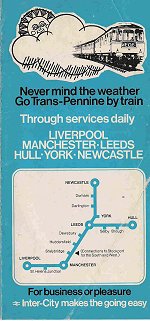
Pictured is a 1970s handbill, courtesy of Richard Farish.
In the early 1970s the sets frequently worked beyond their normal Hull - Liverpool route on fill-in turns. A set worked to Blackpool as part of a booked duty. In 1973 this diagram involved a 5-car non-buffet set working the 13:48 Hull - Manchester Victoria, and after refuelling at Newton Heath it worked the 17:15 Manchester Victoria - Blackpool South, was stabled there overnight and returned on the 07:07 to Manchester, then formed the 12:57 to York. Apparently the sets were introduced on this line in response to well-publicised public dissatisfaction with Blackpool - Manchester commuter trains.
Another example of a fill-in turn was on the 16:40 Hull - Beverley and 17:15 return, this time with a 6-car buffet set.
Botanic Gardens
The Trans-Pennines were all delivered to Neville Hill depot (55H) in Leeds. In 1967 they were transferred to Botanic Gardens depot in Hull where they remained till withdrawal. Even though Botanic Gardens had just been modernised as a diesel depot, it initially lacked a pit for doing engine drops.
They were effectionately nicknamed by staff as "Pennies".
In the final years the regional CM&EE contacted the depot every week for engine and gearbox holdings and telexed Derby Locomotive Works with requirements, Derby being the maintaining engine works. Botanic Garden's all time record was a gearbox which reached 400,000 miles service though this was an exception.
Vehicle Substitutions
It wasn’t at all unusual for other power cars to be mixed with the Trans-Pennines. A missing DMC would often be substituted by a 104 MCL (or in later years, when the 104s had gone elsewhere, a 101 MCL – and certain other MBSs used as well). There has also been complete twins noted in the place of the DMC, and also a sighting of a solo Cravens MBS backing down to Paragon, that came out as a ‘strengthener’ to a full 5 or 6-car set. David Neal recalls travelling on a hybrid set in the mid to late 1970s which had 101 DMBS E50230 at the end of 124 vehicles E51974 (MBS), E59769 (TS), E51973 (MBS) and E51966 (DMC).
The Final Years
The Trans Pennine service gradually declined through the 1970s. The sets continued to give good service but the new M62 started to make the journey times particularly slow, and there was a widening gap in service quality between the Trans Pennine timetable and trains and Inter City services elsewhere which were benefiting from reductions in timings and new air conditioned stock. Mechanical failures became more frequent as the route and age took its toll. The occasional replacement of a car with a Met Camm or Cravens vehicle also reduced the service quality, as the gangways were not compatible so there was no through access.

A five-car set hurtles through Earlestown with the 08.57 Manchester to Liverpool on 23 March 1977. Kevin Lane.
In 1977, BR carried out passenger surveys on the line, causing it to rethink the timetable. It was realised that there was little hope of significant increases in line speed without massive investment. So the alternative was to improve the service quality.
The survey also showed that the traffic flows had changed substantially. Most passengers now travelled between the north-east and Manchester, and the York-Leeds and Leeds-Manchester sections being particularly busy with 325,000 and 200,000 journeys respectively during a period of a week. There were 225,000 passenger journeys between Manchester and Liverpool, but the number of passengers between Hull and Manchester had fallen to just 40,000.
The set pictured is at York station in 1979 on the 11:00 am Sundays only Hull to Leeds via York service. The leading power car was E51963 which as can be seen is fitted with an experimental high intensity headlight. Mike Hudson.
The timetable was transformed for the summer 1979 service, being as dramatic as the 1961 revision. The Hull - Liverpool services went over to loco hauled trains from York - Liverpool, with Hull passengers making a connection via a Hull - Leeds shuttle. More Hull - Sheffield trains were extended to Manchester Victoria using the Hope Valley Line and more through trains were introduced between South Humberside and Manchester. The previous DMUs on this last route were no longer favoured by the public, and would not do for a revamped service. The reliability and availability of the Class 124s was at an all time low despite the valiant efforts of Botanic Gardens staff. It was clear that there would not be sufficient vehicles for the new Hull-Manchester/South Humberside services (this became known as the South Trans Pennine route). However, the WR had redundant Class 123s in store.
Class 123 / Class 124 Hybrids
During April 1977, the ER Chief Passenger Manager approached the regional CM&EE with the proposal to move the Class 123s from the WR to integrate them with the Class 124s and so offer an improved level of comfort - the Class 123s being fitted with B4 bogies and having the same traction equipment. Agreement was reached in this respect in May 1977 and on June 5 of that year, the first of three 3-car units, were transferred, the first being W52092, W52097 and W59820. Indeed, E51964 was inadvertently re-upholstered in second class moquette! At the same time the small six seat 'saloon' in the DMCs were downgraded to second class.
The combined classes became the normal power on the Hope Valley route over the Pennines on workings from the North West to Yorkshire such as those from Manchester Piccadilly through to Cleethorpes via Sheffield and Doncaster and Barnetby. They also putting in daily appearances on services on the Leeds, Keighley, Skipton and Morecambe axis and on various other services in North West England. The units also worked the Manchester to Cleethorpes trains on selected services. There were no accelerations to the timings from Hull-Manchester, same may actually have been slower, but the benefit was in the increased number of services: the 1978 tally of five through trains from Hull and two from Manchester, but from 1979 there were ten each way. Through trains between Cleethorpes and Manchester Piccadilly were increased from one each way to three.
The image shows a set at Doncaster on 10th November 1979. Graham Turner.
The combined fleet was made up into seventeen typically mixed 4-car sets, plenty to cover the twelve diagrams. An example set formation in 1980 could be: Cl 123 DMBS; Cl 124 MBS; Cl 123 TC ; and a Cl 124 DMC. In a formation like this with three power cars they had almost 9hp/ton, or if only two then it was 6.3hp/ton.
In 1981 the engine removal scheme began, the reduction in power did not have any effect on timings.
The Hull - Leeds - Manchester trains were withdrawn in October 1981.
Loco-hauled

It is unclear how widespread this was, but the image shows Class 124 vehicles (the most obvious being the MBS as the second vehicle) in the rake of vehicles departing Bridlington behind 20004 & 20106 with the 11.43 Scarborough to Hull on a summer Saturday, 15/9/79. Lindsay Walters.
Lancaster

When the Nottingham - Glasgow trains were withdrawn from the Settle and Carlise route in 1982 a 'fast' DMU service was introduced from Leeds to Lancaster (for connections to the north) to placate passengers travelling from the West Riding to Carlisle and Scotland. There trains were diagramed for the Class 123/4 hybrids.
The image shows E51954 + E59837 + E59239 + E51955 at Lancaster Castle on the 25th August 1982. Robert Frise.
Around the same time the sets were reformed to eliminate where possible mixed power car sets, which also avoided too many sets having two brake vans and a loss in seating capacity. They were now formed of: nine Cl 123 (DMBS, TC, Cl 124 TS, DMS) giving 24 1st + 196 2nd class seats; five Cl 124 (DMS, TBS, Cl 123 TS, DMC); a unique Cl 124 set in which the Cl 123 TS was a downgraded TC, these six sets gave 30 1st + 196 2nd class seats; and two Cl 124 (DMC, 2x TBS, DMC) which each gave 30 1st + 180 2nd class seats.
The first Trans-Pennine Class 124 was condemned in October 1977, this being No. E51959 which was severely damaged in the collision at Farnley Junction with the York- Aberystwyth train and E51959 was cut up on site.
While in the 1970s they were looked upon as being unreliable, when working with the Class 123s they were regarded as being one of the more reliable DMUs on BR. In the early 1980s they were scheduled to do approximately 100,000 miles annually, about the double the average for other ER DMUs.
| Vehicle | Mileage on May 15 1982 | |
| E51951 | 1477430 | |
| E51952 | 1519180 | |
| E51953 | 1544540 | |
| E51954 | 1470060 | |
| E51955 | 1561120 | |
| E51956 | 1427640 | |
| E51957 | 1611660 | |
| E51958 | 1380670 | |
| E51959 | condemned (had done approx. 1130000) | |
| E51960 | 1501850 | |
| E51961 | 1482200 | |
| E51962 | 1418450 | |
| E51963 | 1414830 | |
| E51964 | 1369620 | |
| E51965 | 1522340 | |
| E51966 | 1492330 | |
| E51967 | 1558290 |
Unusually, records were kept of each of the Class 124 vehicles, although just to May 15th 1982. These are shown in the table, they would cover approximately another 150-200,000 miles before withdrawal.
The last vehicle to receive a C1 repair was No. E51955 in December 1981 and with the end of the class in sight, careful arrangements were made with a view to making the classes last without undue expenditure before the introduction of replacement locomotive hauled (Class 31/4) services on May 14 1984.
E52089 was the final vehicle to receive a new engine and gearbox on May and although it was only scheduled to be in service for a short period, the engine and all other re-usable engines were sent to Bletchley for further use on the Class 115 DMUs which had the same equipment.
Several vehicles were condemned as they became due expensive repairs - worn tyres and tatty internal condition - and on March 19 1984, two of the Trans-Pennine diagrams were turned over to locomotive hauled substitutes. These were forecast by the CM&EE as it was unlikely that all 12 sets could be kept in working order until May 13 1984. The two replacement services were deliberately rostered for the Leeds to Hull section so as to permit easy run-round at Leeds and so avoid operating difficulties.

Just weeks before the end, DMC E51963 is pictured in Hull Paragon on April 23, 1984. 53A Models of Hull Collection.
The last working of each of the diagrams on the final Sunday (13/5/84) was as follows.
22.00 Manchester to Sheffield.
19.45 Manchester to Hull.
22.31 Liverpool to Manchester.
15.38 Sheffield to Hull.
17.45 Manchester to Hull.
19.15 Leeds to Hull.
20.45 Manchester to Hull.
16.45 Manchester to Cleethorpes.
E52098/52100 were the power cars on the last booked working. However, E52090/96 worked the 06:35 Cleethorpes to Doncaster on the Monday morning, May 14.
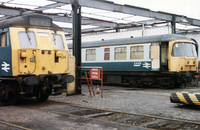
Some vehicles went to Sheffield Darnall depot after withdrawal where, as asbestos contaminated vehicles, they were boarded up for their final journey to the scrapyard. Pictured there circa early 1985 is E51967. Mike Bunker.
No Takers
Upon withdrawal the North Yorkshire Moors Railway (which at the time already had three Swindon DMU buffet vehicles) planned to obtain a three-car set, which was well publicised. Unfortunately the railway had a change of policy at the last minute with concerns about the asbestos insulation. This was the era just before DMU preservation got into full swing so there was no other interest, meaning no vehicles would survive.
Summary
Background
Description
Works Photographs
Diagrams & Design Codes
Numbering & Driving Inst.
Liveries
Operations
Images
No Class 124s were preserved.
Thanks to Ian Fleming for additional information.



